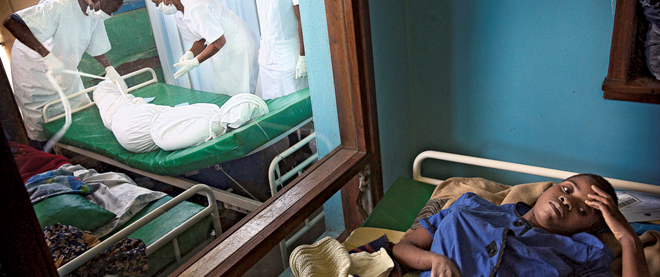How AIDS really got started
A Canadian doctor claims the ‘dead-end’ virus was hiding in plain sight for decades
Daniel Rosenthal/laif/Redux
Share

In 1976, a handful of Belgian nuns were operating a badly needed hospital in Yambuku, a remote village in Zaire. Some 300 patients a day came, many seeking antiviral drugs, which nurses provided via the poorly funded hospital’s five reusable syringes. The result of the inevitable cross-infection was the first outbreak of the blood-borne virus Ebola, which killed 280 of its 318 victims—far more deaths than if there had never been a hospital in the first place.
The Yambuku incident is one of the most harrowing proofs ever recorded of the old adage that no good deed goes unpunished. But the story of the Ebola outbreak differs little in its essentials from that of an exponentially more lethal disease, AIDS. Now marking its 30th official birthday—counting from the 1981 U.S. Centers for Disease Control paper about an unlikely pneumonia cluster in Los Angeles—AIDS has so far killed 30 million people. And in Dr. Jacques Pepin’s convincing account of its history, The Origins of AIDS, it emerges as the greatest man-made health disaster of our times.
The disease itself is much older than 30. Molecular studies show that chimpanzees, hosts to the virus that causes AIDS in humans, have carried it for centuries. Pepin, an infectious disease physician and professor at Quebec’s Université de Sherbrooke, uses mathematical modelling to show that dozens of people—chimp hunters or their wives preparing the meat—must have thereby contracted AIDS. One spouse would then infect the other sexually, but those couples became what Pepin calls in an interview “epidemiological dead ends: the disease would develop in them for a decade, and then they would die, with no effect on the larger population.”
But a disease is one thing and an epidemic very much another. The latter requires—as shown by the way tuberculosis exploded as 19th-century Europeans crowded into unsanitary housing in burgeoning cities—helpful social conditions. In Africa, during the first half of the 20th century, Western imperialism obliged. Vast construction projects designed to exploit the continent’s resources turned thousands of African men into forced labourers, housed in work camps that became disease epicentres. With far less altruism than the Yambuku nuns—the driving motivation was the need for a functioning workforce—colonial regimes launched medical programs against malaria and sleeping sickness.
Antiviral drugs delivered by reusable syr- inges were the main—double-edged—weapons, and, as in Yambuku, AIDS quickly spread among the male population. Enter the second factor in the coming epidemic: the same massive disruption of traditional life that dragooned so many men away from home into nearly all-male enclaves spawned an industrial-scale sex trade, with some high-risk prostitutes servicing up to 1,000 clients a year. For a virus that spreads—unnoticed—by blood or sexual contact, conditions were now ideal.
Looking back, Pepin saw the same medical processes still at work a half century later, during his time as a medical officer at a rural hospital 500 km northeast of Kinshasa in the early 1980s. The hospital’s reusable needles went through its a utoclave unit to kill pathogens, but during power outages (that could last up to two months), “I did not pay too much attention to how long they were boiled by the nurses, and with some drugs in such short supply, even 0.1 ml left in a vial after one patient would be used for the next.”
Further proof AIDS was percolating unseen comes from the fascinating information provided by archival blood. In decades-old samples, scientists found previously unknown cases, including an entire Norwegian family—mother, father, nine-year-old daughter—all dead of AIDS in 1976. The father was a sailor who had visited African ports (and brothels) in the 1960s; he had infected the mother before she infected the daughter during childbirth in 1967. There was also an unlucky Canadian pilot injured in a crash in Zaire in 1976, who died in 1980 of AIDS acquired from the blood transfusion he was given, and AIDS samples that dated to 1959 and 1960. The variation in their viruses indicates their last common ancestor flourished around 1921.
Those First World victims, who died in modern hospitals under the care of puzzled doctors, were also epidemiological dead ends. Not so the third man-made factor in AIDS’ worldwide dissemination. The 4,000 Haitians who worked for the UN in the former Belgian Congo after independence in 1960 did not return to advanced medical care but to a country with a thriving blood-selling business. With both blood and sexual-contact infection routes open, a critical mass of infected Haitians soon arose. Gay American sex tourists brought AIDS home before 1970, as did—possibly—plasma importers. By the late ’70s, after a decade of incubation, sexual freedom and blood supply contamination, the disaster unfolding in Africa was ready to erupt everywhere else.